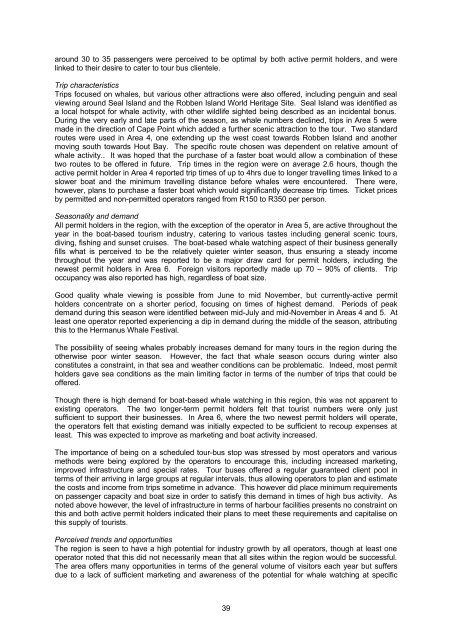Download PDF (2.5MB) - Anchor Environmental
Download PDF (2.5MB) - Anchor Environmental
Download PDF (2.5MB) - Anchor Environmental
You also want an ePaper? Increase the reach of your titles
YUMPU automatically turns print PDFs into web optimized ePapers that Google loves.
around 30 to 35 passengers were perceived to be optimal by both active permit holders, and were<br />
linked to their desire to cater to tour bus clientele.<br />
Trip characteristics<br />
Trips focused on whales, but various other attractions were also offered, including penguin and seal<br />
viewing around Seal Island and the Robben Island World Heritage Site. Seal Island was identified as<br />
a local hotspot for whale activity, with other wildlife sighted being described as an incidental bonus.<br />
During the very early and late parts of the season, as whale numbers declined, trips in Area 5 were<br />
made in the direction of Cape Point which added a further scenic attraction to the tour. Two standard<br />
routes were used in Area 4, one extending up the west coast towards Robben Island and another<br />
moving south towards Hout Bay. The specific route chosen was dependent on relative amount of<br />
whale activity.. It was hoped that the purchase of a faster boat would allow a combination of these<br />
two routes to be offered in future. Trip times in the region were on average 2.6 hours, though the<br />
active permit holder in Area 4 reported trip times of up to 4hrs due to longer travelling times linked to a<br />
slower boat and the minimum travelling distance before whales were encountered. There were,<br />
however, plans to purchase a faster boat which would significantly decrease trip times. Ticket prices<br />
by permitted and non-permitted operators ranged from R150 to R350 per person.<br />
Seasonality and demand<br />
All permit holders in the region, with the exception of the operator in Area 5, are active throughout the<br />
year in the boat-based tourism industry, catering to various tastes including general scenic tours,<br />
diving, fishing and sunset cruises. The boat-based whale watching aspect of their business generally<br />
fills what is perceived to be the relatively quieter winter season, thus ensuring a steady income<br />
throughout the year and was reported to be a major draw card for permit holders, including the<br />
newest permit holders in Area 6. Foreign visitors reportedly made up 70 – 90% of clients. Trip<br />
occupancy was also reported has high, regardless of boat size.<br />
Good quality whale viewing is possible from June to mid November, but currently-active permit<br />
holders concentrate on a shorter period, focusing on times of highest demand. Periods of peak<br />
demand during this season were identified between mid-July and mid-November in Areas 4 and 5. At<br />
least one operator reported experiencing a dip in demand during the middle of the season, attributing<br />
this to the Hermanus Whale Festival.<br />
The possibility of seeing whales probably increases demand for many tours in the region during the<br />
otherwise poor winter season. However, the fact that whale season occurs during winter also<br />
constitutes a constraint, in that sea and weather conditions can be problematic. Indeed, most permit<br />
holders gave sea conditions as the main limiting factor in terms of the number of trips that could be<br />
offered.<br />
Though there is high demand for boat-based whale watching in this region, this was not apparent to<br />
existing operators. The two longer-term permit holders felt that tourist numbers were only just<br />
sufficient to support their businesses. In Area 6, where the two newest permit holders will operate,<br />
the operators felt that existing demand was initially expected to be sufficient to recoup expenses at<br />
least. This was expected to improve as marketing and boat activity increased.<br />
The importance of being on a scheduled tour-bus stop was stressed by most operators and various<br />
methods were being explored by the operators to encourage this, including increased marketing,<br />
improved infrastructure and special rates. Tour buses offered a regular guaranteed client pool in<br />
terms of their arriving in large groups at regular intervals, thus allowing operators to plan and estimate<br />
the costs and income from trips sometime in advance. This however did place minimum requirements<br />
on passenger capacity and boat size in order to satisfy this demand in times of high bus activity. As<br />
noted above however, the level of infrastructure in terms of harbour facilities presents no constraint on<br />
this and both active permit holders indicated their plans to meet these requirements and capitalise on<br />
this supply of tourists.<br />
Perceived trends and opportunities<br />
The region is seen to have a high potential for industry growth by all operators, though at least one<br />
operator noted that this did not necessarily mean that all sites within the region would be successful.<br />
The area offers many opportunities in terms of the general volume of visitors each year but suffers<br />
due to a lack of sufficient marketing and awareness of the potential for whale watching at specific<br />
39
















